 American Serb History 101
American Serb History 101
with Baba Mim....
Check out my other websites too:
Not Retired From Learning! http://www.notretiredfromlearning.com
and....
Bizic Education Enterprises.
"The Power of Three"--> www.mimbizic.com
And the Moon Township Historical Society website:
Serbian History 101
PA
United States
m
- Home & St. Sava
- Who's Who-NIKO NEMA Sto Srbin
- Role of the Gusle, Guslar
- Slava
- Orthodoxy
- Christmas Customs
- Serbian Wedding
- Orthodox Baptism
- Kosovo
- Kosovo & V. Rev. Fr. Mateja Matejic, Hilandar and Ohio University Scholar
- About Your Hostess, Mim Bizic
- Gus Bizic, Francza, and more good stories
- +Gus & Mim Bizic's Wedding Photos
- Andja Mamula's Folk Costume/Arrival in America
- Milan Karlo & Ellis Island Medal of Honor Nomination 1986
- Milan M. Karlo, Photographer
- Early Days: Serbian Settlers
- SNF Karlo-Bizic Scholarship
- SNF Centennial Photo Exhibit
- 102 Anniversary: Gary/Merrillville, Indiana, Mim's Speech
- 2012 Kuma Mim for St. Elijah's Aliquippa
- Jules Bobik: God Knows Your Name!
- Rose Karlo Gantner in Viet Nam
- Pittsburgh Serb History
- St. George Cemetery/Sasha Petrov, Ned Marich
- Pittsburgh Steel History & Karajlovich Family
- Patriotic Songs of the Serbs
- Bishop Nikola & WWI orphan situation
- WWI & Malvina Hoffman & Serbs
- WWI Serbian Generals
- WWI, Gary Volunteers, Ted Erceg, St. Sava's Merrillville, IN, and Steve Gacesa
- WWI Virtual Gallery
- WWI, Part 2: American Ally and Serbian Sacrifice
- WWI-Allies Postcards & Medals
- 75th Anniversary of Operation Halyard, Rescue of 500+ Airmen
- WWII, Draza Mihailovich & Operation Halyard
- WWII, Draza, Part 2
- WWII, Draza Part 3
- WWII Rescued Airmen, Part 4
- WWII, Page 5
- Draza Comic Books 1942, Part 6
- WWII Crepajac Library, Part 7
- Draza Mihailovich-Part 8: Aleksandra Rebic, Prajani Airfield
- WWII, Part 9, Ruth Mitchell, and Mihailovich, Hitler's #1 Headache
- Part 10: Mim Not Mum on Serbia
- Part 11: Capt. Mansfield's speech @ Draza 1953
- Part 12: Curtis (Bud) Diles, U.S. Airman, Operation Halyard
- Part 13: Farewell Arthur (Jibby) Jibilian
- George Vujnovich, Operation Halyard, more
- Early St. Sava Day Celebrations in California
- You know you're Serbian when.....
- Famous Serbs
- Pittsburgh SNF Three-Day 2010!
- Aliquippa Singing in Canada 2014
- Arbutinas of Freedom, PA
- Vojvoda Golub Babic in 1903
- Helen Delich Bentley's 40 Day Parastos 9/24/16
- Bishops of Eastern America, Mitrophan and Irinej
- George Budimir/Canada
- Cheran Family
- Novak (Nole) Djokovic cookies & more!
- Boris Dobrovolsky, Professor of Music
- Down Memory Lane
- Bora and Draga Dragasevich
- Galveston, TX History
- Interesting tidbits
- In Memorium: Stella Jatras
- Johnstown, PA - Much more than "Flood City!"
- Nikola/Nada Jovic-Canada
- King Alexander of Yugoslavia
- Petar Kokovich (Kovich)-Olympic Gold Medalist 1912
- Kosovo Men's Choir
- Kumstvo and the Todorovichs
- Lysaght, Machaskee, Tadic & the SBAA
- Larry Maravich, Mitch Trivanovich and George Pevac
- Vljako Lugonja and the Serbian Singing Federation
- Stevo Medich's Schlivo Cake
- Metropolitan Christopher
- Metropolitan Irinej
- Tripo Mitrovich-Galveston, TX
- St. Bishop Nikolai & His Letters
- +Milan Opacich, USA National Treasure
- Nikola (Rasha) Musulin
- Vladika P. Petrovic Njegos
- Patriarch Pavle's Funeral
- Ned Payne: Big Game Hunter
- Popovich Brothers
- Ordination of Deacon Chris Rocknage
- Bill Salatich-Gillette
- Momchilo Savatic, Survivor
- Sargentich Smithsonian Watch
- Serbian Embassy In Budapest, Hungary
- Serbian handicrafts
- Serbian Monasteries you should know
- Serbian Numismatics & Medals
- Serbian Old Maps, Old Books
- Serbian Organizations
- Serbian Proverbs from Mladenovac, Serbia
- Serbian recipe samples
- Serbian Singing Federation (SSF) with Paul Bielich
- Shadeland Camp
- Sports & Serbs
- V.Rev.Fr.Stevan Stepanov
- Slobodan Zelich, Composer and Director
- Website Testimonials
- Website Contributors
- Social Marketing Tools for You
- Contact

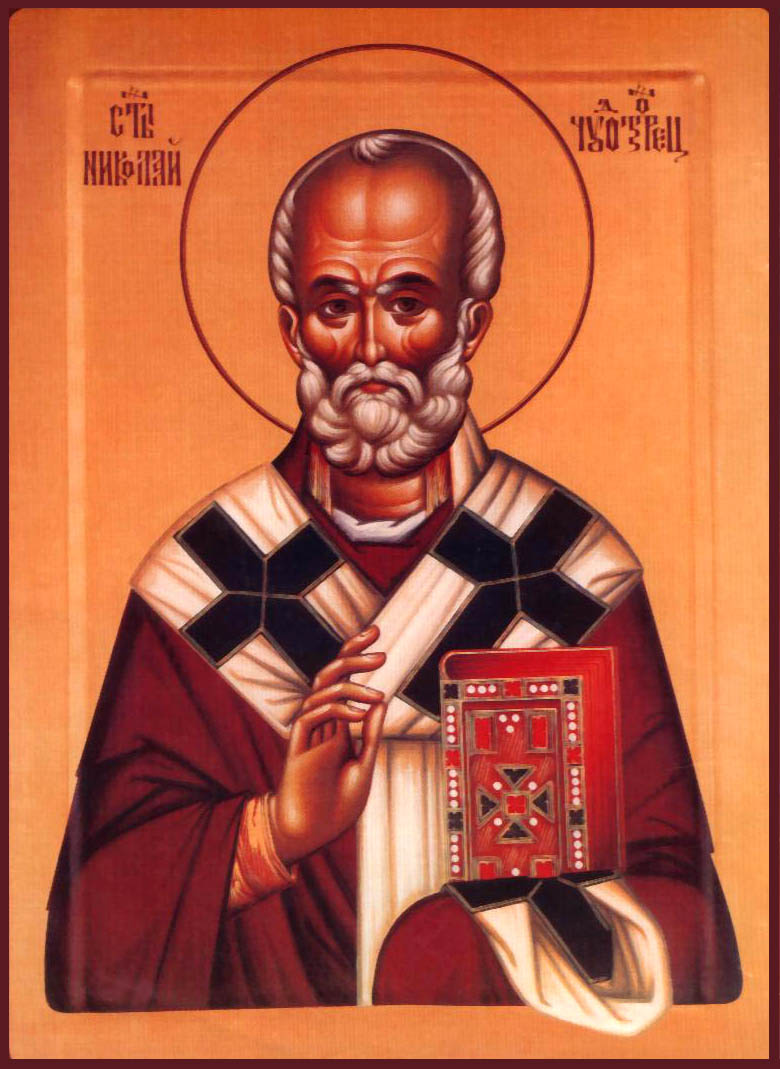 Slava (Niko Nema Sto Srbin Imade)
Slava (Niko Nema Sto Srbin Imade)
SLAVA-Celebration (No One Has What the Serb Has)
Слава (Нико Нема Сто Србин имаде
"Where there is a Slava, there is a Serb!"
"Gde je Slava, tu je Srbin!"
"Где је Слава, ту је Србин!"
++++++++++++++++++++
If you click on the bottom right corner, you will be able to view this article about SLAVA much better.

Sts. Cyril and Methodius are the two saints credited with converting the Slavs from paganism to Christianity in the late 9th century. The saintly apostles traveled from village to village, baptizing the inhabitants in Christ's name.
Tradition holds that the Slava date chosen was closest to the time of a saint's birth when the people of the village were baptized en masse by the two apostles of Christ. That's why you will find that many Serbian families whose ancestors came from the same area, celebrate the same "Slava."
Serbians remember the day their early ancestors converted to Christianity by keeping their family's "Slava" or Celebration Day holy and very special.
The Slava date is passed down from generation to generation through the head of the household. Therefore, you know that when you celebrate your Slava, you're reaching back into history through the centuries, secure in the knowledge that one of your family's DIRECT ancestors celebrated that day also. It's a "ties that bind" trait that Serbians value dearly. It's the "birthday" of their family's faith in Christ, the "Christening" of their first baptized ancestor. It's one of the most valuable of all treasures or gifts a family can pass on to their progeny.
St. Paul said every Christian home is like a little church. Serbs pray to God every day for the health and well-being of their family members. On the Slava Day, it's a chance for the family to pause and thank God and the Patron Saint for the family's many blessings. Most families begin their day in church.
(Pevac Family celebrates St. George Slava)
Jessica & Georgette with their incredible Kolach!
Tomei's: Always present in church on May 6th!

St. George celebrants in St. Elijah's Serbian Orthodox Church in Aliquippa, PA, May 6, 2013, with Pastor, V.Rev. Father Stevan Stepanov.

Since the above people celebrate St.George as their Krsna Slava, isn't it wonderful to be able to hear this old record called "Oj Djurdjev Danak" - St. George's Day by the Jorgovan Tamburitzans!
(From the collection of Steve Kozobarich of Cleveland.)
+Kum Rudy Ignatovic was so devout in his love of his St. Archangel Michael Slava! Slava mu!
Popular Slava dates include St. Nicholas (Dec. 19), St. George (May6), St. John the Baptist (Jan.20), St. Stephen (Jan.9), St. Archangel Michael (Nov. 21) and St. Demetrius (Nov.18), St. Trifun (Feb.14), and there are many more.
St. Sava's Day (January 27) is the Slava of ALL Serbs, especially the Serbian children, and to him children recite poems ("declamaticas") to honor the Archbishops' teachings. It was St. Sava who first introduced the Slava canonically to the Serbs. "St. Sava" is the most popular church name.
 Children's cookie gifts in honor of St. Sava Slava
Children's cookie gifts in honor of St. Sava Slava****************************************
Here is a very fancy kolach from out west that was made for St. Nicholas' Day, 2010 by Protonica.

Each Serbian Orthodox Church celebrates a "Slava" in honor of the saint to whom the church was dedicated.


Koledin Family-Happy Celebrant Kumovi
"Где је Слава, ту је Србин!"
"Gde je Slava, tu je Srbin!"
"Где је Слава, ту је Србин!"

"Pomozi Boze i Sveta Krsna Slava nasa!
"Da se slavimo i Tobom se hvalimo!
"Srecna Slava, srecni gosti, ko dosaso, dobro nam dosao, jos bolje nas nasao.
"Neka Bog sacuva dusmanske ruke i svakojake muke!
"Sto nam Bog da, nek nam i sacuva;
"Spasi Bog!"
++++++++++++++++++++++++++++++++
Don't forget to plant your wheat (Zito) on Sveti Nikola Day (Dec. 19th) for your psenica for Christmas.
This is what it will look like after only 3 or 4 days!
++++++++++++++++++++++++++++++++
St. Nicholas and the Darr Mining Disaster,
December 19, 1907
On Dec. 20, 1907, it made the front page of the New York Times, and the headlines of the Pittsburgh Press (St. Nicholas Feast Saves the Russians) the Pittsburgh Gazette Times (Majority of Victims Americans-Foreign Workers Lay Off to Go to Church and Escape Death) and the Pittsburgh Dispatch. A mining disaster at the Darr Mine in Van Meter, in the south-western corner of Pennsylvania occurred, killing at least 239 English speaking miners, but the toll could have been much higher, closer to 500! Still, it remains the fourth worst coal mining diaster in U.S. history as everyone inside the mine was killed.
Some 250 faithful Carpatho-Russian immigrant coal miners (we're sure there were Serbs & other Orthodox Slavs) had taken an unpaid day off work to celebrate St. Nicholas' Day on December 19. He has been the Patron Saint for Slavs for centuries, and thanks to his intercession, men and boys (some only as old as 10 years old!) had survived to become parents and grandparents. If it weren't for this miracle, more than a thousand would have been widowed and orphaned. And no assistance would have been given from the company in those days!
"Even the greedy coal mine owners, who otherwise had virtually complete control of their miners with threats of dismissal, knew that they could not force Carpatho-Russians to work on 19th December, St. Nicholas Day."
The above paragraph is from the account of the Centenary of the Miracle of St. Nicholas in Pennsylvania. Newspaper reports of the 11:30 AM explosion took place in the middle of the church service record there was a terrible noise and the ground shook, as if there were an earthquake. Immediately everyone realized that there had been an explosion in the mine and they rushed to help find survivors. Although it had been illegal and against the few regulations that did exist at the time, the mining company had allegedly interconnected more than one mine, which devastated a large area of the mine on both sides of the river. Many bodies could not be identified and were placed in a mass grave.
The Centenary Account says that life was very hard for the Carpatho-Russian miners, who had to work like animals in the bowels of the earth, exploited by the anglo-American businessmen and coal barons, having to work seven days a week. At the time, the report goes on, Fr. (now St.) Alexis Toth (1854-1909) supported every labor struggle and won the respect of the people and helped them struggle to retain their ORTHODOX identity and traditions (having been forced into Uniatism in their homeland by the threat of starvation in the 17th and 18th centuries). Since 1892, the report says, the people had been returning to Orthodoxy to the the united Orthodox Church in North America. "The Roman Catholic Uniates were as a rule anti-labor and supported their Irish masters. The Carpatho-Russian miners remained close to the Church and many later revered the memory of the Russian Tsar-Martyr, Nicholas II, under whom all Orthodox in North America had been united."
"The 1907 miracle in Pennsylvania, which took place according to the Orthodox calendar date of St. Nicholas Day, only served to hearten the exploited Carpatho-Russian immigrants who had returned to Orthdoxy, comfirming them in their choice of Faith and encouraging others to do likewise in later years."
On Dec. 19, 2007, an Akatist was celebrated at the St. Nicholas Orthodox Church at Jacobs Creek, close by where "the Miracle of St. Nicholas the the Darr Mine" occurred. A new troparion and kontakion had been composed for the occasion and the new content, describing the miracle of the saving of the coal miners, was added to the service.
++++++++++++++++++++++++++++++++
The Serbian Orthodox Church Net website offers an incredible booklet prepared by V.Rev. Fr. John Todorovich of Merrillville, Indiana. It tells the History of the Slava, how to prepare, what the hosts does on his Patron Saints Day, the cutting of the Slava Bread, the meaning of certain rituals, the Hymn "O Holy Martyrs," the augmented Litany, social aspects of the Slava Celebration, a recipe for the Slava Kolach and the Wheat, and a beautiful biography of the Late Ralph Papich in whose memory this book was made by his devoted wife.
Slava by Serbian Orthodox Church Net
+++++++++++++++++++++++++++++++
St. George's Day: May 6.
George, a Captain in the Roman Army, tore up an edict of Emperor Diocletian in defiance, which had ordered the persecution of the Christians. George battled the devil, symbolized by the dragon, and saved the Holy Church, symbolized by the king's daughter shown in a number of icons. St. George rides a white horse that indicates God's grace carrying him to the heroism of martyrdom.
Constantine the Great built a great church over his tomb in Lyda of Palestine. The name George means "Tiller of the Earth."
O Great among the Saints and Glorious George, since you are a deliverer of captives and a defender of the poor, a physician for the sick and a noble attendant to kings, intercede with Christ God that HE may save our souls!
+++++++++++++++++++++++++++++++
SVETI NIKOLA SLAVA in Gracanica, Kosovo 12/19/09
People who celebrate Sveti Nikola as their Slava bring their Kolachs to church (the Monastery here) to be blessed.)
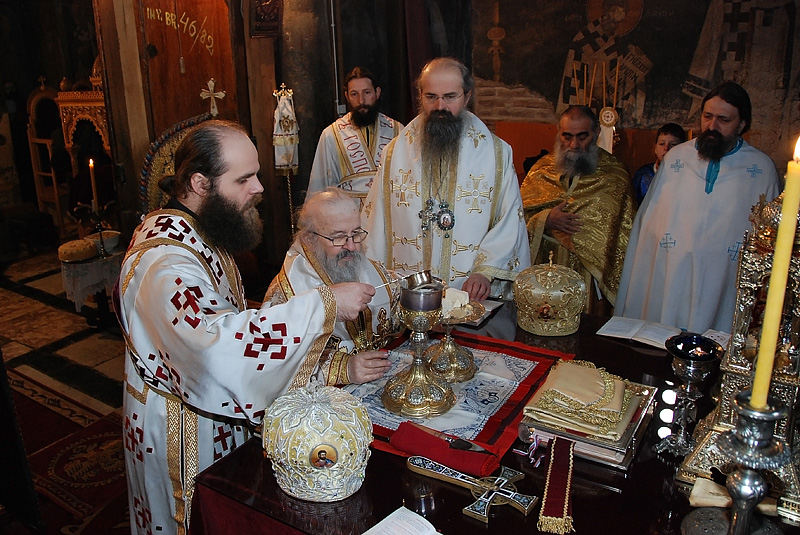
Bishop Artemije in the Gracanica altar.....

Bishop Artemije's Slava of Sveti Nikola celebrated.
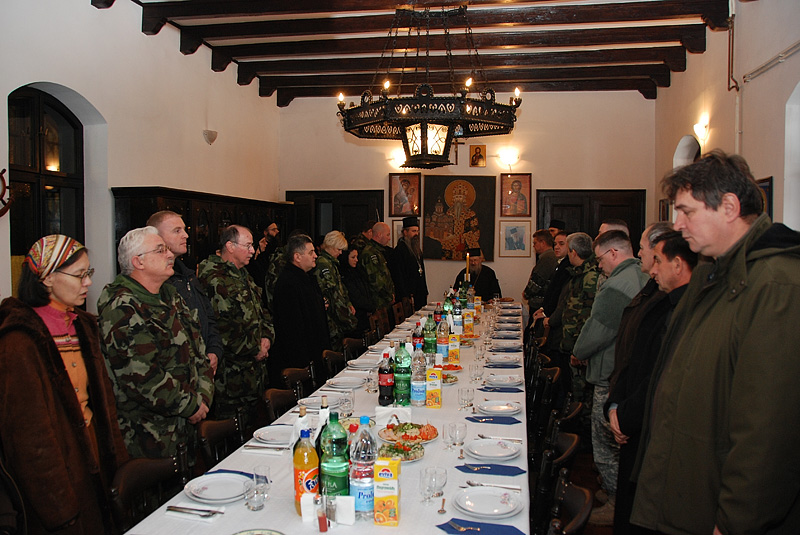
Many guests, including those Peacekeepers who guard Gracanica Monastery.
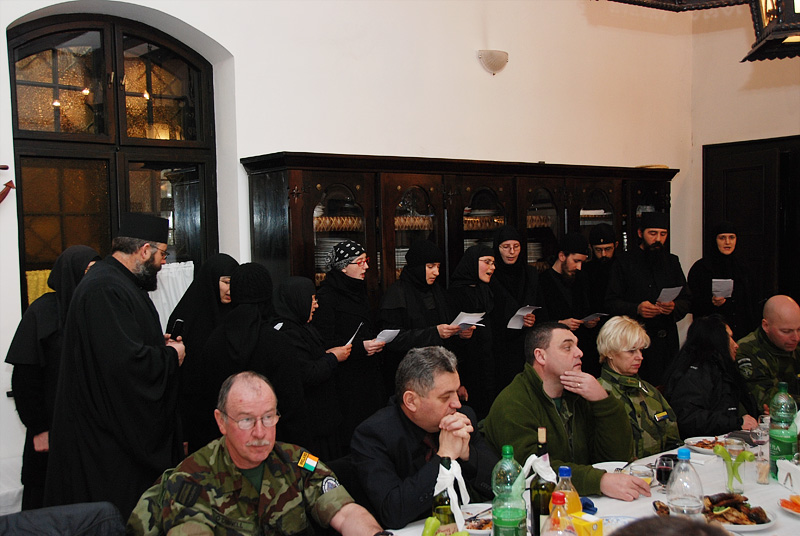
The Sister Nuns added so much to the happy occasion by singing beautiful hymns and chants.
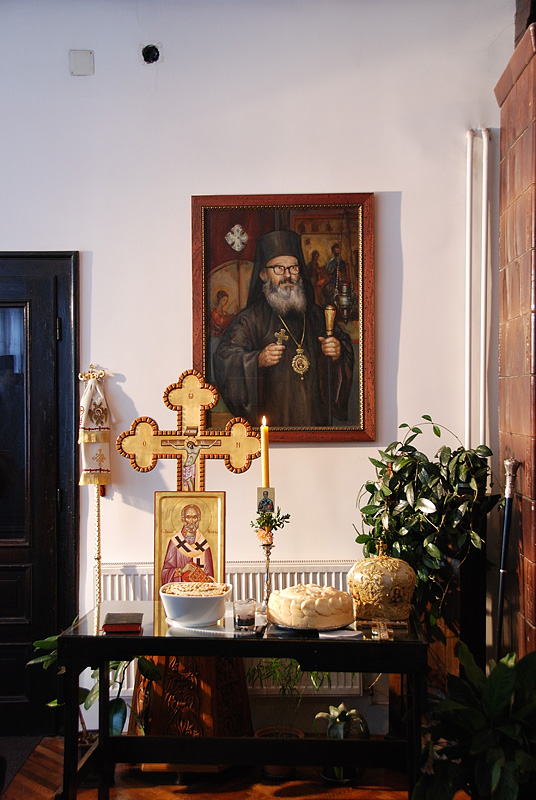
Bishop Artemije's Slava is Sveti Nikola too!
+++++++++++++++++++++++++++++++
You're never too young to start your own psenicas!

2009
Houston and Pittsburgh
Psenica started 12/19/09.
Notice little round box with trobonica.
It holds dirt from Kosovo from 1989,
600th anniversary of the Battle of Kosovo.
++++++++++++++++++++++++++++++++
Wonderful YouTube video of St. George posted by Stefan Jajcic.
http://www.youtube.com/watch?v=n8WVdoc9pQs&feature=related
Песма Светом Великомученику Георгију Победоносцу
Георгије мучениче, Георгије победниче,
кроз муке си победио и на небу прославио.
Све си сматр'о јефтиније од Истине, Георгије!
За Хришћанство све си дао, уз живога Христа стао!!!
Георгије мучениче, Георгије победниче,
трвен, ломљен страшном муком, беше држан Божијом руком...
Твоје муке беху лаке због Божије руке јаке.
Све се теби поклањамо, твоје име прослављамо!
Георгије мучениче, Георгије победниче,
о, смилуј се данас нама заштити нас молитвама.
Пред престолом Христа Бога, нашег спаса свемоћнога,
да се муке не страшимо - да трпљењем победимо!!!
+++++++++++++++++++++++++++++++
Stefan Rajcic is also responsible for this YouTube video on St. John the Baptist (Sveti Jovan-Jan.20)

http://www.youtube.com/watch?v=mTpYLUPkOK0
Ој, Свети Јоване, дивни Kрститељу,
ти претеча беше славном Спаситељу...
Ја се теби клањам, ја се теби молим
помози да свакој напасти одолим...
Ја се теби клањам пророку најачем
и пред тобом клечим и пред тобом плачем...
Доведи и мене до Христових ногу
помози да стигнем где ја сам не могу...
Ти укрепи мене молитвама твојим
да чист и праведан пред Господом стојим...
Нек се ја смањујем мој ће Христос расти,
док је Христос велики ја нећу пропасти!!!
+++++++++++++++++++++++++++++++
The Janicijevich Family Slava is Sveti Petka, Oct. 27 of each year. It is always a time of great fellowship, respect for traditions, and fine food. Guests come from many miles away to help celebrate, and are always filled with savory food, sincere love, and excellent musical entertainment.
Here, October 27, 2011, Dr. Nenad Janicijevic welcomes guests and announces a NEW member, Dr. Kam, will be joining the family shortly with his wedding to Nada. Ziveli, Mladenci!
Notice the beautiful kolach (symbolic Slava bread) above made by Dr. Milena janicijevic.
 Dr. Milena Janicijevic in front of the Zhito (wheat) she made for the Slava and served to guests as they arrived. Slavsko zhito (wheat) represents the death and resurrection of Christ. Christ reminded us that except a grain of wheat die it cannot rise again, even as it was necessary that He die, be buried, and on the third day rise again so that we all can triumph over death. The Slavsko zhito is prepared as an offering to God for all of the blessings we have received from Him; it also is to honor the Patron Saint and to commemorate our ancestors who lived and died in the Orthodox faith.
Dr. Milena Janicijevic in front of the Zhito (wheat) she made for the Slava and served to guests as they arrived. Slavsko zhito (wheat) represents the death and resurrection of Christ. Christ reminded us that except a grain of wheat die it cannot rise again, even as it was necessary that He die, be buried, and on the third day rise again so that we all can triumph over death. The Slavsko zhito is prepared as an offering to God for all of the blessings we have received from Him; it also is to honor the Patron Saint and to commemorate our ancestors who lived and died in the Orthodox faith.
Behind Dr. Milena is an icon of The White Angel, purchased by Dr. Nenad Janicijevic in Studenica Monastery while on a Pilgrimage to Gazi Mestan for the 600th anniversary of the Battle of Kosovo in 1989.
All of the Janicijevics, including Dr. Nenad's brother, Predrag, helped with the relief efforts for Serbia during the war. Dr. Nenad personally escorted medicines and donated medical equipment from the Tri-State Pittsburgh area to the war-torn country many times and has been recognized with a medal of St. Sava for his great humanitarian work. Ziveli, Janicijevics, all! Thank you from all of us!
++++++++++++++++++++++++++++++++

++++++++++++++++++Celebrating The Krsna Slava gives us Confidence, Strength, Freshness, Stability, Spiritual and Physical Peace, the Ability and Incentive to do good and to lend a hand to others.
++++++++++++++++++
Ko Slavu Slavi, Njemu i Bog Pomaze!
"Whoever celebrates his/her Slava, God Watches & Helps"
++++++++++++++++++
How to make a Slavski Kolach
(Serbian Bread for Slava)
(This recipe can be found on the Annotated Bibliography page for recipe.)
++++++++++++++++++
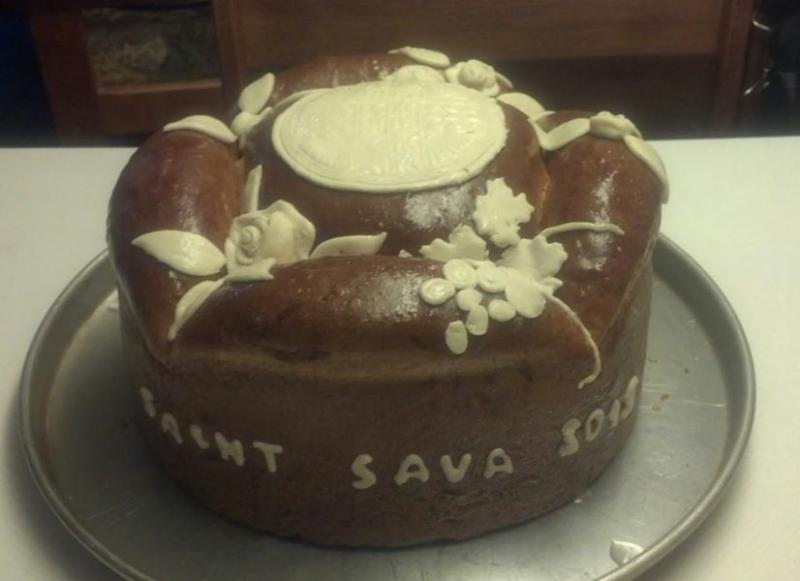
Kolach and Žito made by Georgette Brnjilovich Osman
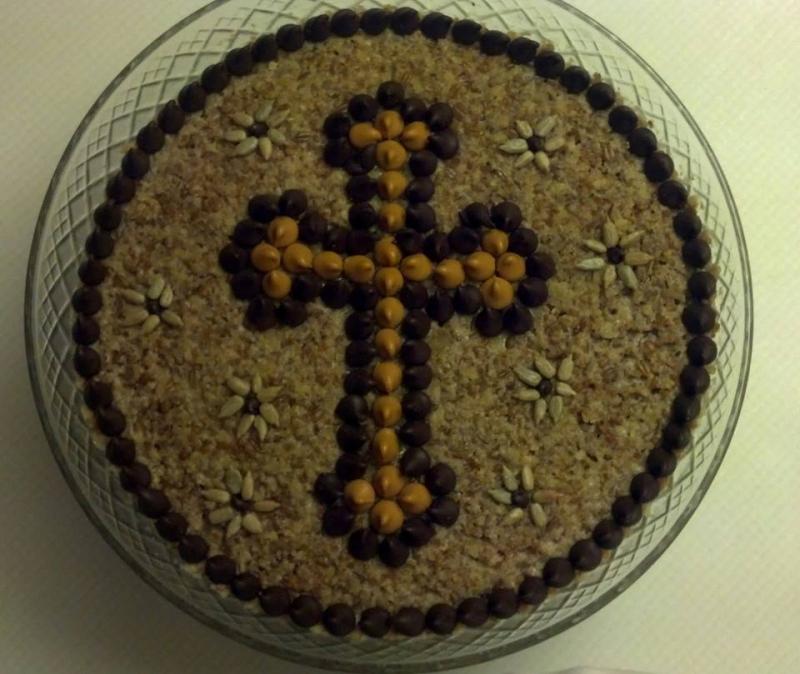
"There are 4 basic elements that have to be present on Slava table: candle, slava bread cake called Kolach, red wine and cooked wheat or Zhito.
Slava cake iKolach) is ritually cut either by a priest in the church on the morning service or by the man of the house and first guest that comes.
The Slava cake (Kolach) represents Christ’s body, wine is his blood, cooked wheat is a symbol of resurrection while a candle proclaims Christ as the light of the world.
Usually families prepare large feasts for their guests and entire roasted pigs and lambs can be found onthe table followed with many side dishes, salads and desserts.
However, if a slava falls during one of 4 big fasts (before Christmas, Easter, day of St. Peter and Paul and the Assumption of the Virgin Mary) then the food should be prepared by the rules of the fast which means without meat, eggs and dairy products, but fish is allowed.
++++++++++++++++++
Although most Slavas are celebrated with traditionally rich foods, some Slavas are celebrated as strict Fast days, such as St. Nicholas (Dec. 19). No meat, no dairy products are allowed that day, but that doesn't stop families from celebrating bountifully (see photo below).

St. Nicholas' Day is very special, because on Dec. 19, Serbians "plant" their wheat in order to have a beautiful "psenica" for Serbian Christmas (January 7), which, according to custom, promises good fortune for the coming year!
Some people plant the wheat in dirt. Others just use water.
Getting ready.....
Here come the green shoots!
After a few days....
ALMOST ready for Christmas (Jan. 7) with the tri-colored Serbian ribbon!

Greeting card 2008 from New Gracanica Monastery read:
We're not giving Kosovo away.
Vidovdan, the day of the Battle of Kosovo in 1389, is another Slava all Serbs celebrate on June 15 or June 28, according to the church calendars.
Сачувај Кристијан Косова


"The commemoration of Krsna Slava was to our ancestors one of the most important expressions of their Orthodox faith. So they always celebrated their Krsna Slava, regardless of how dangerous the situation.
The Serbian Krsna Slava links, as a golden string, our past and our present, our ancestors and their descendants. Serbian people should never ignore their Krsna Slava because through it the Orthodox faith was preserved and they were held together through the centuries.
"Slavsko zhito (wheat) represents the death and resurrection of Christ. Christ reminded us that except a grain of wheat die it cannot rise again, even as it was necessary that He die, be buried, and on the third day rise again so that we all can triumph over death. The Slavsko zhito is prepared as an offering to God for all of the blessings we have received from Him; it also is to honor the Patron Saint and to commemorate our ancestors who lived and died in the Orthodox faith.
"Slava's bread represents Jesus Christ as the Bread of Life. It is also symbolic of our thanks to God for being saved through Its Son. During Slava, the priest cuts a cross in the bread, which reminds us of Christ' S death on the cross for the remission of our sins.
"The red wine, of course, represents Christ’s precious blood, which was required to wash our sins away.
Note that understanding the symbols of Slava helps us understand the meaning of the celebration. There is one symbol, the Slavsko zhito, that needs some special explanation. Some of the faithful have the misunderstanding that the Slavsko zhito is parastos for the Patron Saint of the Slava. The wheat for Slava and the wheat for parastos (Koljivo) are two different things. In both cases, the wheat symbolizes resurrection and eternal life (St. John 12:24); however, Slavsko zhito is prepared for the glory and honor of the Saint and for the repose of the souls of those departed members of the family who commemorated that Saint. We do not pray for the soul of the Patron Saint, but we pray that he or she intercede to the Lord our God for the forgiveness of our sins. Therefore, you should never place a candle in the Slavsko zhito.
"For the faithful, Krsna Slava creates confidence, strength, freshness, stability, spiritual and physical peace, and the ability and incentive to do good and to lend help to others. If we want to be the meritorious heirs of our ancestors, keeping our origin, history, and symbols of Krsna Slava, we can't permit the flame of our Krsna Slava candle ever to be extinguished.
"The importance of Krsna Slava is not to have a huge, elaborate, and expensive party. All you need is the Icon of your saint, a candle, wheat, bread (kolach), and wine, the service of the priest, and an awareness that Krsna Slava is a great treasure passed on to you by your ancestors.
"Do not fail to keep this ancient and honorable Serbian Orthodox tradition and to pass it on to your children. As St. Paul says in his epistle to the Thessalonians (2:15), 'Stand firm and hold to the traditions which you were taught."
Bishop Artemije
12/19/09
Sveti Nikola's Slava
Come celebrate the VOLITICH Slava of St. Basil the Great with us!
St. Basil is recognized for his Divine Liturgy that is celebrated three times a year, but also for caring for the material needs of the faithful as well. It was Basil the Great who established the first hospitals, first orphanages and first homes for the elderly. He was a strong defender of the Faith-standing up for the true teachings of the Church throughout the lengthy Arian heresy that caused division among believers in the 4th Century. St. Basil is referred to as "a bee of the Church of Christ, bringing honey to the faithful, but stinging those in heresy."
The Volitichs are indeed considered bees in the Church of Christ, working tirelessly in all areas!
Happy Slava!

George & Marlene Volitich and children, grandchildren, and Great-grandchildren!
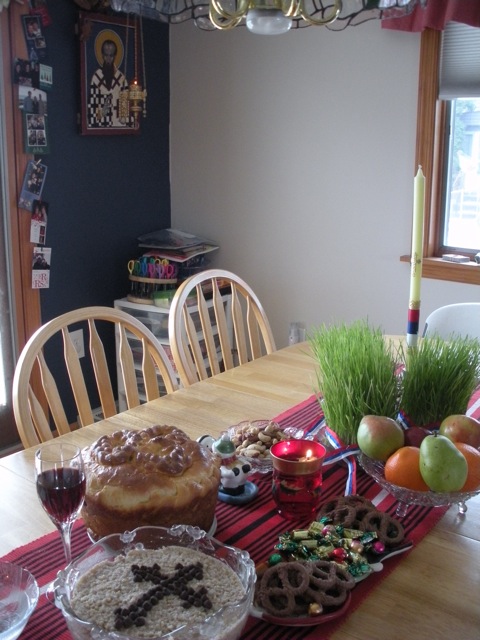
Kolach & Koljivo, psenica and candle.


 Seya Mabee: July 31, 2011. She truly deserved the Honor.
Seya Mabee: July 31, 2011. She truly deserved the Honor. 


General Draza Mihailovich's "THANKSGIVING" Slava prepared for Americans Lt. Col. Albert Seitz and OSS Major, George Musulin,
Nov. 25-26, 1943



Just click on the lower right hand corners of the pages to enlarge to be able to read this story written by Mim Bizic for the American SRBOBRAN, on Feb. 18, 2004.
Serbian History 101
PA
United States
m





















